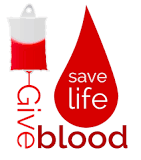Red Cross Declares Emergency Blood Shortage, Calls for Donations During National Blood Donor Month
January 16, 2024Number of U.S. blood donors hits all-time low for past 20 years; Red Cross and NFL offer those who come to give a chance to win a trip to Super Bowl LVIII
The American Red Cross is facing an emergency blood shortage as it experiences the lowest number of people giving blood in the last 20 years. Blood and platelet donations are needed now to help alleviate the shortage and ensure lifesaving medical procedures proceed without delay.
“One of the most distressing situations for a doctor is to have a hospital full of patients and an empty refrigerator without any blood products,” said Dr. Pampee Young, chief medical officer of the Red Cross, the nation’s largest blood supplier. “A person needs lifesaving blood every two seconds in our country — and its availability can be the difference between life and death, however, blood is only available thanks to the generosity of those who roll up a sleeve to donate.”
Don’t wait — make an appointment today to give blood or platelets to help ensure people receive the care they need. Book now by using the Red Cross Blood Donor App, visiting RedCrossBlood.org or calling 1-800-RED CROSS (1-800-733-2767).
BLOOD DONATION CHALLENGES Over the last 20 years, the number of people donating blood through the Red Cross has fallen by about 40%. When fewer people donate blood, even small disruptions to blood donations – such as the nearly 7,000-unit shortfall in blood donations the Red Cross experienced between Christmas and New Year’s Day alone – can have a huge impact on the availability of blood products and dramatic consequences for those in need of emergency blood transfusion.
Additional challenges lie ahead as winter weather and seasonal respiratory illnesses like the flu and COVID-19 may affect future donor turnout compounding the dire blood supply situation that the nation currently faces.
Several factors have contributed to the decline in blood donors as the way in which people engage in the communities where they live, learn and work has evolved over the past two decades. Most recently, COVID-19 accelerated this decline as more people embraced remote work making it challenging to meet people where they are with convenient blood drives. Prior to the pandemic, some eligibility changes were implemented to safeguard donors, such as raising the minimum hemoglobin thresholds, resulting in an increase in donor deferrals especially among young donors (16–18-year-olds). More than a decade ago, there were also changes in blood transfusion protocols at hospitals that impacted the demand for blood. These changes illustrate the convergence of several factors that has made it challenging to keep and grow a motivated donor base to meet patient needs over the past two decades.
‘HOSPITAL FLOORS ARE FULL OF KIDS THAT NEED THAT BLOOD’ Ivy Ward’s 9-year-old son Finn has received “more [blood] products than I ever thought one person could take” since he was diagnosed with B-cell acute lymphoblastic leukemia in 2021. “Just in the last two years, he received more than 25 blood products and he’s just one kid,” she said. “The hospital floors are full of kids that need that blood and would otherwise not be able to survive without it.”
A longtime blood donor, Ward is grateful to everyone who gives, so her son Finn — and others in need of treatments — can continue to live. “Without donated blood products, Finn wouldn’t be here today,” said Ivy.
SPECIAL THANK YOU TO THOSE WHO COME TO GIVE The Red Cross and the National Football League (NFL) are partnering this January, during National Blood Donor Month, to urge individuals to kick off 2024 with a blood or platelet donation. Those who come to give blood, platelets or plasma in January will automatically be entered for a chance to win a trip for two to Super Bowl LVIII in Las Vegas. Terms apply; visit RedCrossBlood.org/SuperBowl for more information.
BLOOD DONATION ELIGIBILITY A blood donor card or driver’s license or two other forms of identification are required at check-in. Individuals who are 17 years of age in most states (16 with parental consent where allowed by state law), weigh at least 110 pounds and are in generally good health may be eligible to donate blood. High school students and other donors 18 years of age and younger also have to meet certain height and weight requirements.
Blood and platelet donors can save time at their next donation by using RapidPass® to complete their pre-donation reading and health history questionnaire online, on the day of their donation, before arriving at the blood drive. To get started, follow the instructions at RedCrossBlood.org/RapidPass or use the Blood Donor App.


















